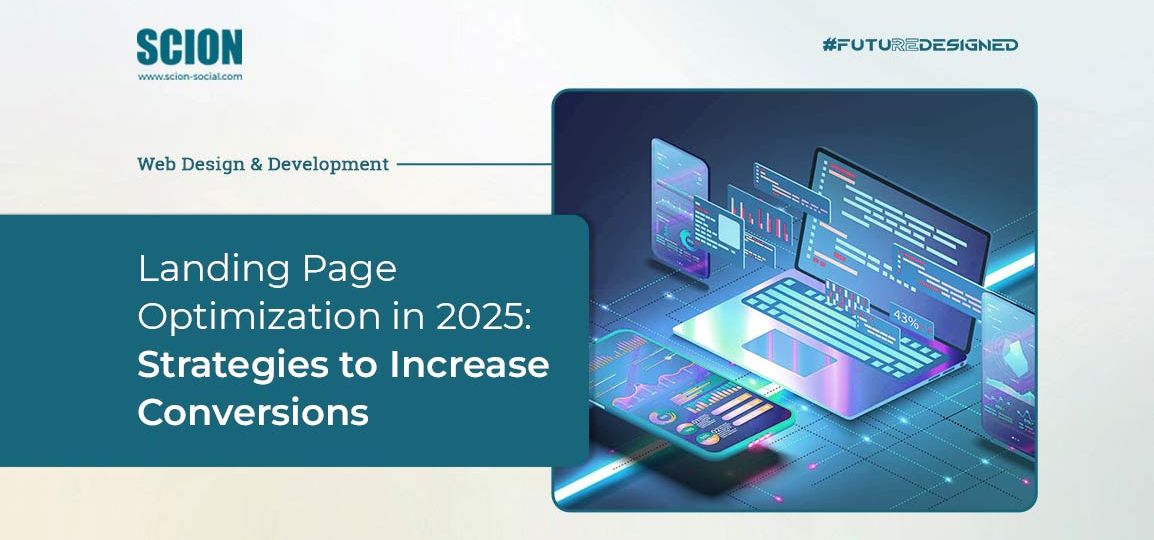
Today’s audiences are harder to impress than ever. And that’s why, in 2025, a landing page can’t just be functional – it needs to be fast, relevant, and built for trust.
Consumer expectations have shifted. Search behavior has evolved. And with discovery happening across more platforms than ever – from ChatGPT to TikTok and Instagram search – your landing page is often your first and only shot to convert.
The good news? With the right strategy, you can build landing pages that are aligned with what users want right now AND what they’ll expect even more of in 2026.
Whether you’re launching a new product or refreshing a campaign, this guide to landing page optimization in 2025 provides the updated strategies and tools you need to increase conversions and stay ahead. Because even experienced marketers risk leaving results on the table if they’re still using last year’s playbook.
So, let’s update your strategy.
Why Landing Page Optimization Still Matters in 2025
Consumer skepticism is at an all-time high. Scams, fake reviews, and spammy funnels have made trust harder to earn. At the same time, digital noise is louder than ever. Everyone claims to be the best, so true differentiation isn’t just optional. It’s essential.
And with discovery happening across an explosion of platforms – from TikTok and Instagram search to ChatGPT links and YouTube descriptions – users are landing on your page with less context than ever.
Translation: Your landing page has to convert cold, distracted, mobile-first traffic with little to no context. That’s a big shift.
Key Landing Page Conversion Trends in 2025
You’re no longer just competing for clicks. You’re competing for belief, attention, and action in a distracted, credibility-starved market. At the same time, AI is transforming how landing pages are built, tested, and personalized, opening the door to faster workflows, deeper insights, and smarter decisions.
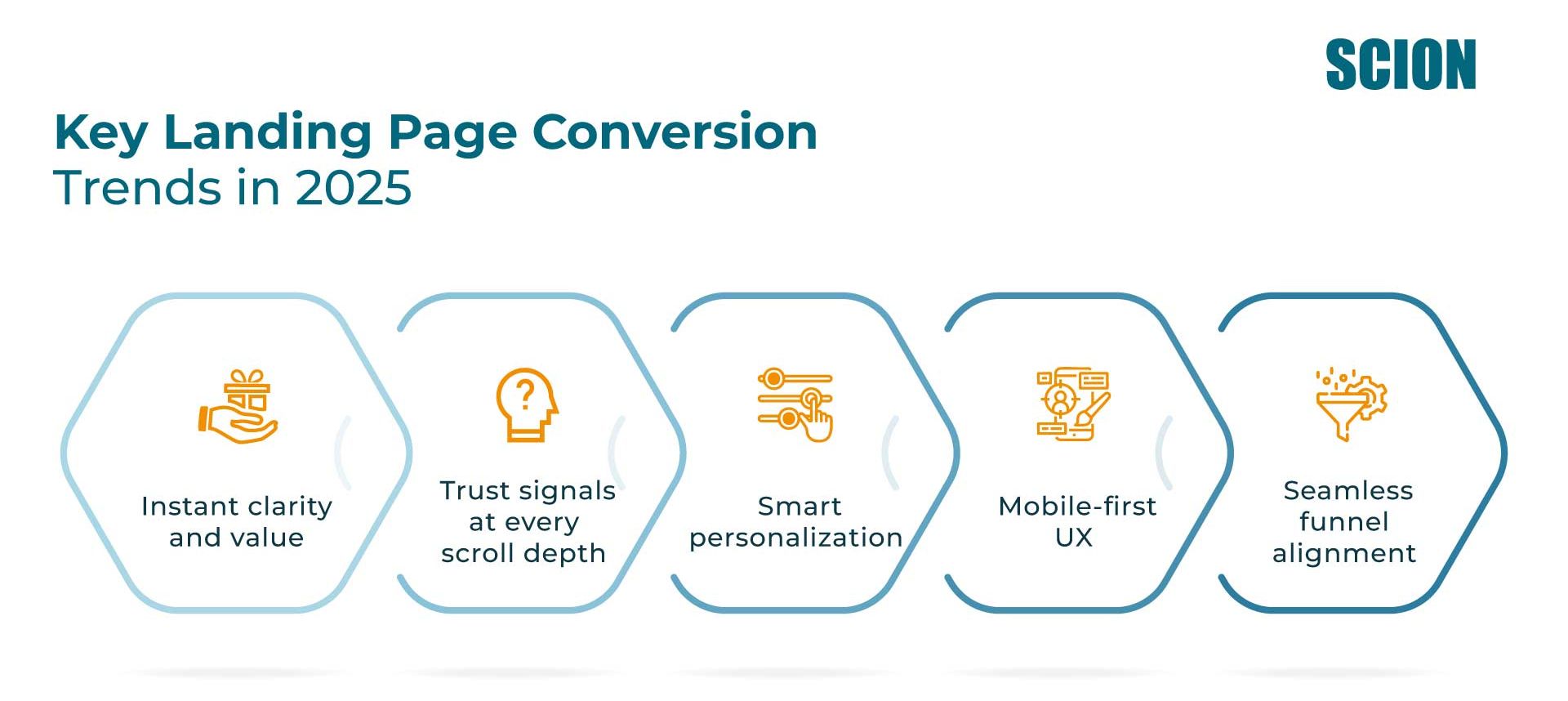
- Instant clarity and value
Visitors should understand what you offer and why it matters within the first few seconds – before they scroll, click, or bounce. Clear headlines and benefit-driven copy are non-negotiables. - Trust signals at every scroll depth
Modern users are skeptical, so you need credibility throughout the page. Reviews, badges, testimonials, media mentions, and transparent language reinforce trust at every step. - Smart personalization
Dynamic content that adapts based on user behaviour, traffic source, or segment makes the experience feel relevant and targeted, increasing the likelihood of engagement and conversion. - Mobile-first UX
With most users landing on your page from mobile devices, your layout, speed, navigation, and CTAs must be optimized for smaller screens and touch interaction from the start. - Seamless funnel alignment
Every element – from the messaging to the CTA – must align with where the user is in the buyer journey and match the promise made in the ad, email, or referral that brought them there.
Understanding the Role of a Landing Page in Your Funnel
Landing Page vs Homepage: Know the Difference
Your homepage introduces. Your landing page converts. Where the homepage covers broad brand messaging, the landing page is designed with one goal, for one audience, at one stage of the funnel.
Aligning with the Buyer Journey
Each landing page must:
- Speak directly to the intent of the user.
- Match the messaging of the ad, email, or referral.
- Guide them to the next step (form, purchase, download)
Top Strategies for Landing Page Optimization in 2025
1- AI-Powered Conversion Rate Optimization (CRO)
Artificial Intelligence isn’t optional anymore. It’s a competitive edge.
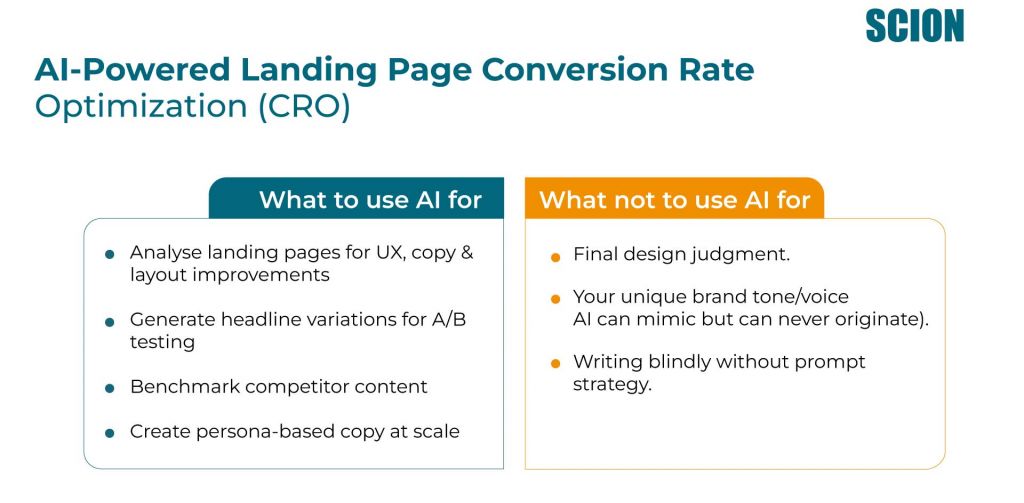
What to use AI for:
- ChatGPT: Analysing your existing landing page to identify UX, copy, and layout opportunities.
- Generating a laundry list of headline variations for you to filter A/B testing.
- Conducting competitor content analysis and benchmarking.
- Creating segmentation-based copy for different personas at speed and scale
What not to use AI for:
- Final design judgment.
- Your unique brand tone/voice (AI can mimic but can never originate).
- Writing blindly without prompt strategy.
2. Personalization & Dynamic Content
To stand out in 2025, your landing page needs a personal touch. Users are more likely to convert when they feel an offering is specific to their needs
- Use dynamic text to change messaging based on the visitor’s source, device, or behaviour.
- Align your story with your visitor’s worldview. For example:
- Hustle entrepreneurs: Focus on speed and independence.
- Eco-conscious users: Emphasize sustainability impact.
New Age Social Proof
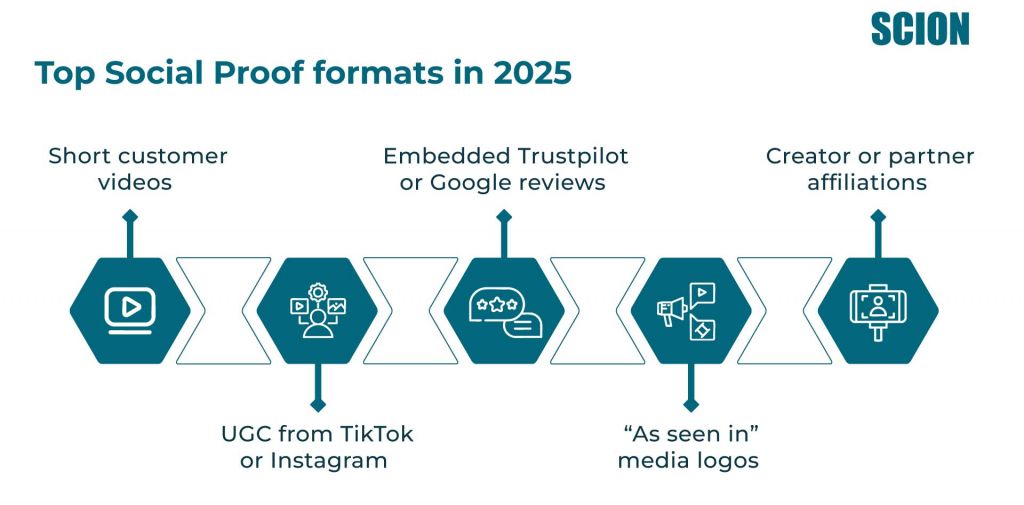
Go beyond static testimonials. Instead, you can use:
- Short customer videos
- UGC from TikTok or Instagram
- Embedded Trustpilot or Google reviews
- “As seen in” media logos
- Creator or partner affiliations
3. Voice Search Optimization
Voice search is growing, especially on mobile.
Use conversational phrases and structure your content so it answers questions clearly. This increases discoverability across AI search platforms and helps with accessibility.
Landing Page Design & Layout Best Practices
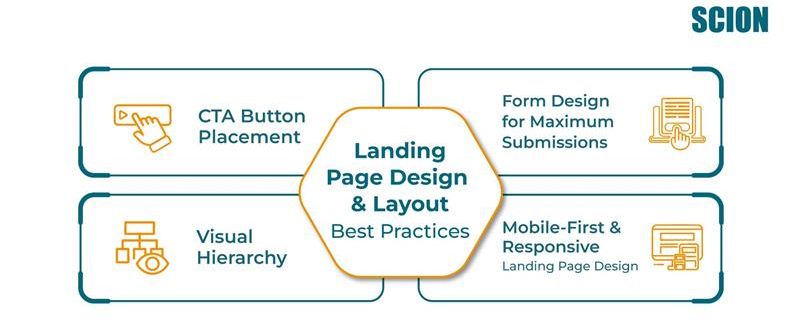
CTA Button Placement
- Make your CTA visible above the fold.
- Repeat the CTA in natural scroll positions.
- Use contrasting colours, not your primary brand colour, to make buttons stand out.
Visual Hierarchy
- Highlight key benefits early.
- Use icons and short blurbs.
- Use directional cues (arrows, visuals, white space) to guide attention.
Form Design for Maximum Submissions
- Keep forms short (3–5 fields max).
- Use multi-step forms if needed.
- Show progress and use autofill where possible.
Mobile-First & Responsive Landing Page Design
Mobile landing page optimization is non-negotiable.
- Test across multiple devices.
- Avoid large blocks of text.
- Compress images for fast load times.
- Use sticky CTAs.
Copywriting That Converts
Great design gets attention, but strong copy is what drives action. In 2025, your landing page copy needs to do more than describe. It needs to persuade, segment, and convert, all before attention span runs out.
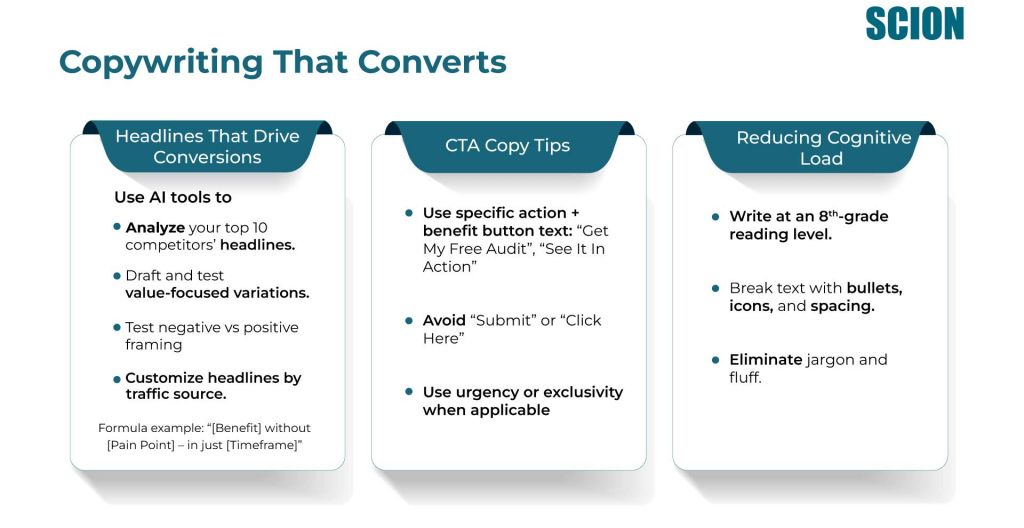
Tools & Tech for A/B Testing & Analytics
A/B Testing Techniques That Work in 2025
A/B testing isn’t just about changing a button colour anymore. It’s about testing the complete experience to match user expectations and intent. Here are proven techniques and test formats to help you dial in what actually works.
A/B Testing Ideas to Try:
- Headline Variations: Test clarity-focused vs. benefit-driven headlines using AI-generated variations.
- Hero Section Formats: Static image vs. autoplay video vs. social proof carousel.
- Form Placement: Above-the-fold vs. after benefit stack.
- Multi-Step Form vs. Single-Step: See if breaking forms into 2–3 steps improves completion rates.
- CTA Testing: “Get My Free Demo” vs. “See It in Action” vs. “Start Building Now.”
- Urgency Elements: Countdown timer vs. “limited spots” vs. none – test to avoid false urgency backlash.
- Personalization Blocks: Dynamic content based on source (e.g., a TikTok user sees different messaging than a Google Ads visitor).
Formulas & Approaches:

- A/B/n testing: Test more than two variants at once when traffic volume allows.
- Split URL testing: Perfect for testing entire layouts or landing page concepts.
- Multivariate testing: If you have enough traffic, test combinations of headline, CTA, and visual together.
- Holdout testing: Reserve a percentage of traffic for a control experience to measure lift accurately.
Analytics: Going Beyond Clicks and Conversions
Most marketers track basic metrics: clicks, bounce rate, and conversions – but that’s just surface-level insight. If you’re building your landing page with code or a standard WordPress setup, you might be missing out on deeper behavioural analytics that can massively improve your conversion rate optimization (CRO) efforts.
Tools like Instapage, for example, offer more advanced insights. Instead of just seeing how many people clicked or converted, you can:
- View heatmaps to see where users are clicking or ignoring.
- Track scroll depth to understand how far people get before they drop off.
- Use session recordings to observe hesitation, confusion, or rage clicks in real time.
- Analyze mouse hovers to spot where attention is focused (or lost).
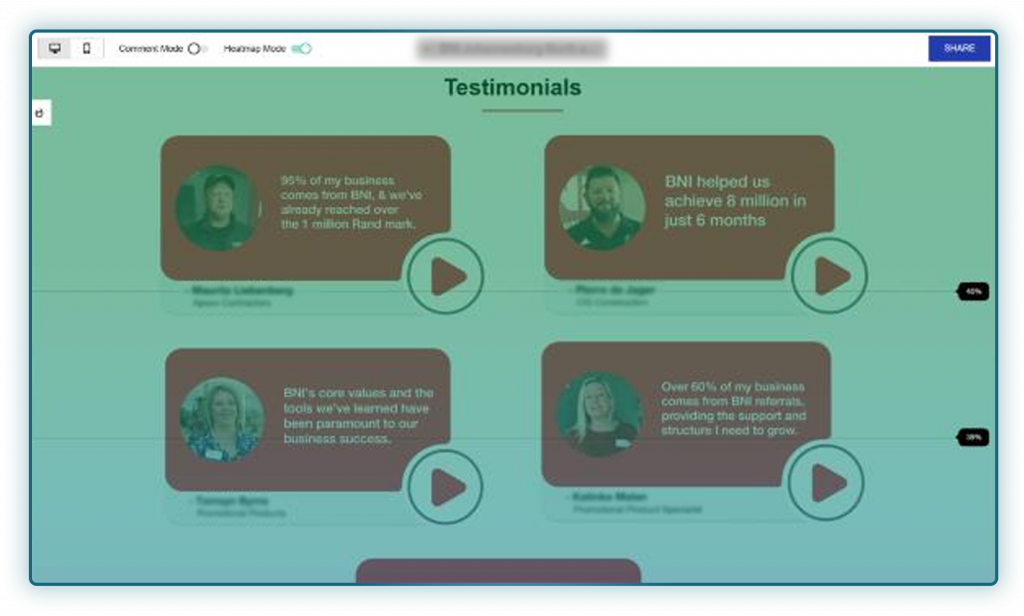
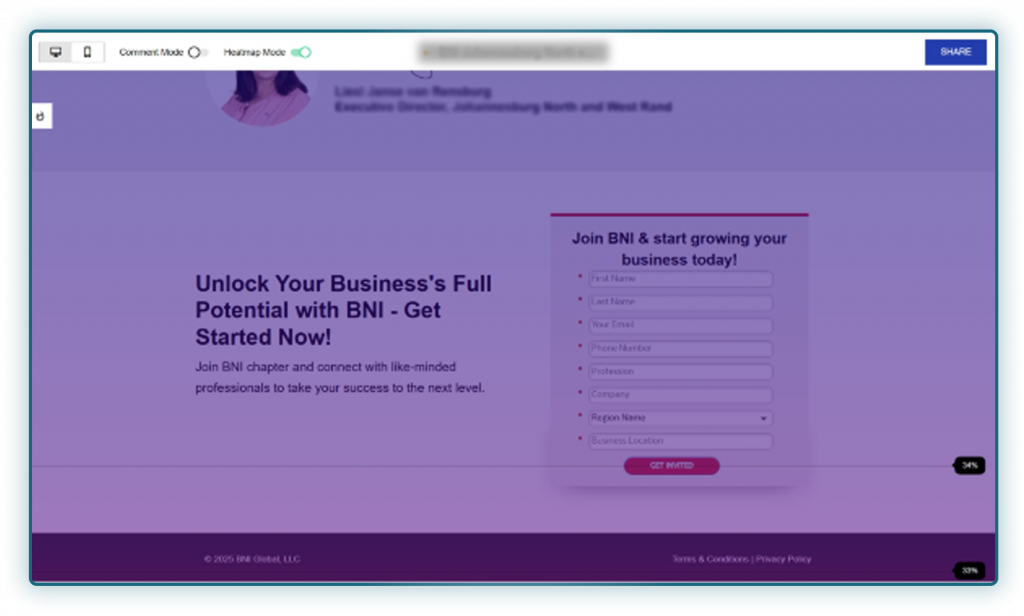
This kind of granular insight shows you what users are actually doing (not just if they clicked) and is critical for refining layout, copy, and flow.
Recommended Tools for 2025
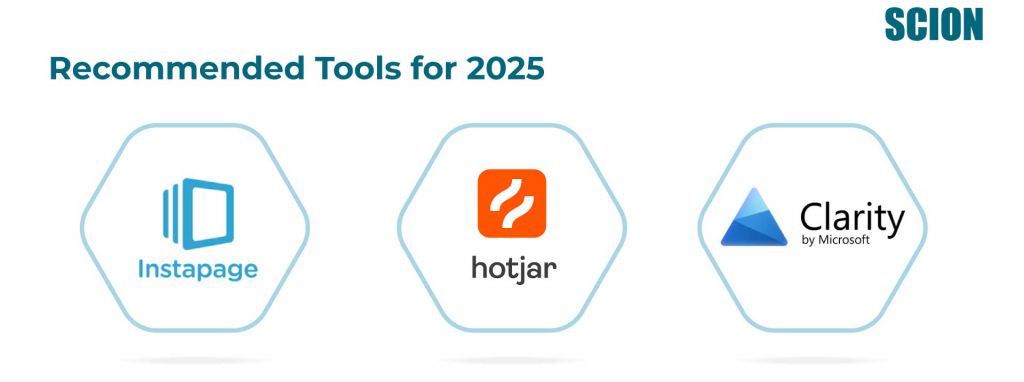
- Instapage: All-in-one platform with powerful A/B testing and visual analytics
- Hotjar: Heatmaps, scrollmaps, and session recordings
- Microsoft Clarity: Free heatmaps and behaviour analytics
How to Use Heatmaps, Scrollmaps & Session Recordings
Heatmaps: See where people click
Heatmaps show you the “hot” and “cold” areas of your landing page based on where users are clicking (or trying to click).
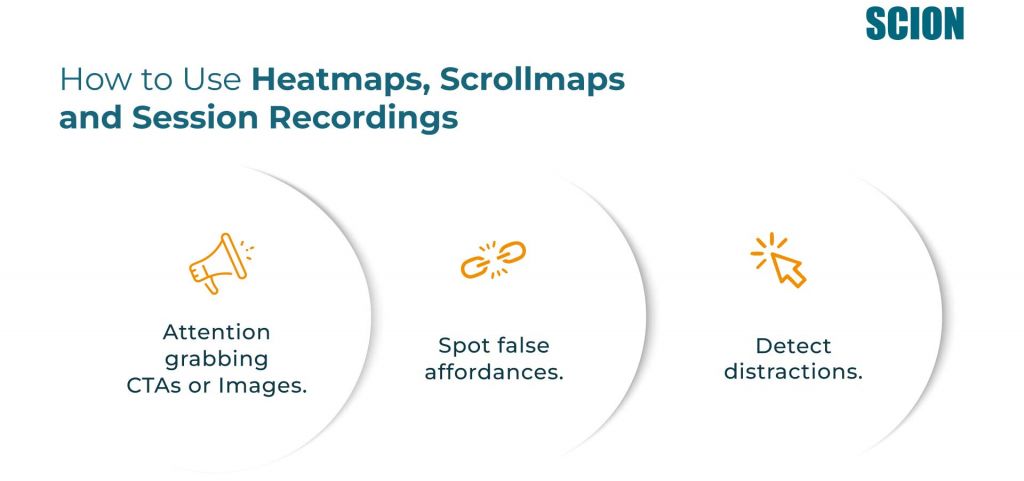
Use them to:
- Identify which CTAs, images, or buttons are attracting attention (and which are being ignored).
- Spot false affordances. These are areas users think are clickable (like underlined text) but aren’t.
- Detect distractions, like clicks on non-essential elements (e.g., logos or footer links) that may be pulling users out of the conversion path.
Actionable tip: If people are consistently clicking on a feature image or product name that isn’t linked, consider turning it into a clickable CTA or anchor point.
Scrollmaps: See how far people get
Scrollmaps visualize how far users scroll down your page and where drop-offs happen.
Use them to:
- Find your “fold line” (the point where a significant percentage of visitors stop scrolling).
- Ensure that your most important content (benefits, CTA, form) appears before that drop-off point.
- Spot engagement cliffs: sudden drops in scrolling can signal confusing sections or poor transitions.
Actionable tip: If only 40% of users reach your testimonials or pricing section, consider moving that content higher up the page, or reworking the section above it.
Session Recordings: Watch user behaviour in real time
Session recordings allow you to watch real users navigate your landing page, capturing mouse movements, clicks, scrolls, and pauses. It’s like a playback of their experience.
Use them to:
- Identify hesitation points: Where do users hover, scroll back, or stop?
- See how users interact with forms (e.g., where they abandon or mis-click).
- Understand behaviour across device types. Especially mobile, where UX friction is often higher.
Actionable tip: Watch recordings from high-bounce sessions and non-converting visits to find patterns such as confusion over form fields, users missing the CTA, or getting stuck on dropdown menus.
Common Landing Page Mistakes to Avoid
Even with great design and solid traffic, a few critical missteps can quietly kill your conversions. Avoid these all-too-common landing page pitfalls and make sure your optimization efforts are working for you rather than against you.
Long Forms
Asking for too much too soon is one of the fastest ways to lose leads. In 2025, users expect frictionless experiences, so limit your forms to essential fields only. If more info is needed, use a multi-step form or ask for additional details after the initial conversion.
No Social Proof
In a trust-driven market, the absence of social proof creates doubt. Without testimonials, reviews, logos, or UGC (user-generated content), visitors may hesitate – especially when comparing you to competitors who do show credibility. Add relevant, visible, and believable proof throughout the page.
Generic CTAs
CTAs like “Submit” or “Click Here” are vague and don’t communicate value. Your CTA should tell users exactly what they’ll get and why it matters.
For example: “Get My Free Quote”, “See It In Action”, or “Start My Trial – No Card Needed”.
The more specific and benefit-focused, the better.
Improper Mobile Optimization
With the majority of traffic now mobile-first, a non-optimized experience isn’t just inconvenient. It’s a deal-breaker. If your page loads slowly, has cramped text, or misaligned buttons on mobile, users will bounce before they ever see your offer. Prioritize responsive design, fast load times, and thumb-friendly layouts.
What’s Next in Landing Page Optimization
1. Predictive Personalization: Smarter Pages for Smarter Traffic
In 2025, personalization goes beyond just using someone’s name. It’s about showing the right message to the right person at the right time, automatically. Predictive personalization uses audience data, ad context, and behavioral cues to dynamically tailor your landing page content, increasing relevance and conversions.
There are two key ways this is being used effectively today:
- Search-Term-Based Personalization
Platforms like Instapage now integrate with Google Ads to match landing page headlines with the exact ad a user clicked. For example, if a visitor searches for “SEO for e-commerce,” the landing page they land on can dynamically show a headline like:
“eCommerce SEO That Drives Real Growth”.
This seamless handoff from ad to page instantly reinforces intent and relevance, reducing friction and bounce.
- Audience Segment Personalization
You can also tailor landing pages based on who the user is – such as their industry, location, or role. If your target is real estate professionals, your page might say:
“Digital Marketing for Real Estate Agents Who Want More Listings”. This speaks directly to their world, increasing both trust and conversions.
With AI and automation, creating multiple versions of your landing page no longer requires multiple hours of design. Smart platforms allow you to create dynamic content blocks, auto-segment visitors, and test performance across variations, all at scale.
2. Integration with Chatbots & AI Assistants
Seamless customer interaction isn’t limited to static forms or FAQ pages. Chatbots and AI assistants have become crucial tools to engage visitors instantly and guide them through the conversion journey. Integrating these intelligent tools into your landing pages enhances user experience, reduces friction, and drives higher conversions.
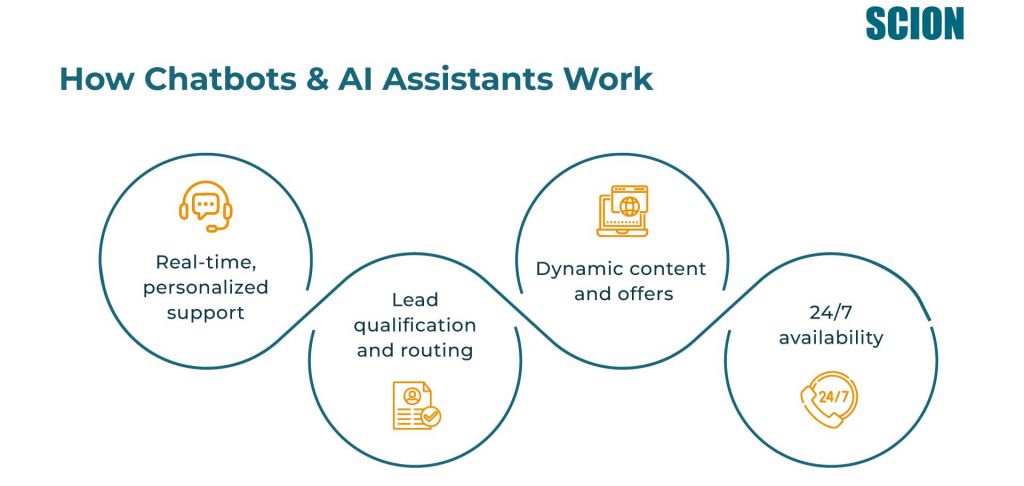
- Real-time, personalized support: AI-powered chatbots can answer visitor questions immediately, provide tailored recommendations, and help users navigate your page without waiting for human assistance.
- Lead qualification and routing: Chatbots can capture important visitor information and qualify leads based on their responses. Instead of relying on generic forms, chatbots engage users conversationally, which often results in higher completion rates and better-quality leads.
- Dynamic content and offers: Some AI assistants can adjust landing page content or offers in real time based on chatbot interactions. For example, if a visitor expresses interest in a particular feature or package, the chatbot can trigger a personalized CTA or display relevant case studies right on the page.
- 24/7 availability: Unlike human teams, AI chatbots work round the clock, capturing and nurturing leads anytime your audience visits. This ensures no opportunity is lost, even outside business hours or across different time zones.
By integrating chatbots and AI assistants directly on your landing pages, you create a more interactive, helpful, and responsive experience; meeting today’s consumer expectations for instant, personalized engagement and setting your brand apart in a crowded digital landscape.
3. Using GA4 and AI Models to Tailor Experiences
With the rise of privacy-first tracking and machine learning, traditional analytics tools have evolved – and GA4 (Google Analytics 4) is now a key part of optimizing landing pages intelligently.
GA4 doesn’t just show you what happened. It helps predict what’s likely to happen next, using AI-powered models to surface audience insights like purchase probability, churn likelihood, and predictive revenue.
Here’s how to apply that to landing page experiences:
- Tailor messaging by engagement level
Use GA4’s predictive metrics to create different landing page variants for high-intent users vs. cold traffic. For example, if GA4 predicts a user is likely to convert, show them an aggressive offer or short-form CTA. For low-intent or first-time visitors, present more education or social proof to build trust first. - Segment by behaviour patterns
GA4’s event-based tracking lets you identify how users engage across your funnel. Combine that with AI models to trigger personalized landing pages such as content tailored to users who have visited pricing pages before, or those who typically bounce after a few seconds. - Build smarter retargeting flows
Integrate GA4’s insights with ad platforms to retarget users with landing pages designed around what GA4 predicts they care about. If a user is likely to purchase within 7 days, you can serve a retargeting ad + landing page experience focused on urgency or a limited-time incentive.
The bottom line? GA4 + AI modeling helps you stop guessing and start adapting, in real time, to the signals your users are giving off. It’s not just about tracking anymore. It’s about tailoring every click and scroll to meet users where they are.
Conclusion: Ready to Optimize?
Landing page optimization in 2025 requires speed, intelligence, and empathy. You can’t afford to rely on outdated strategies.
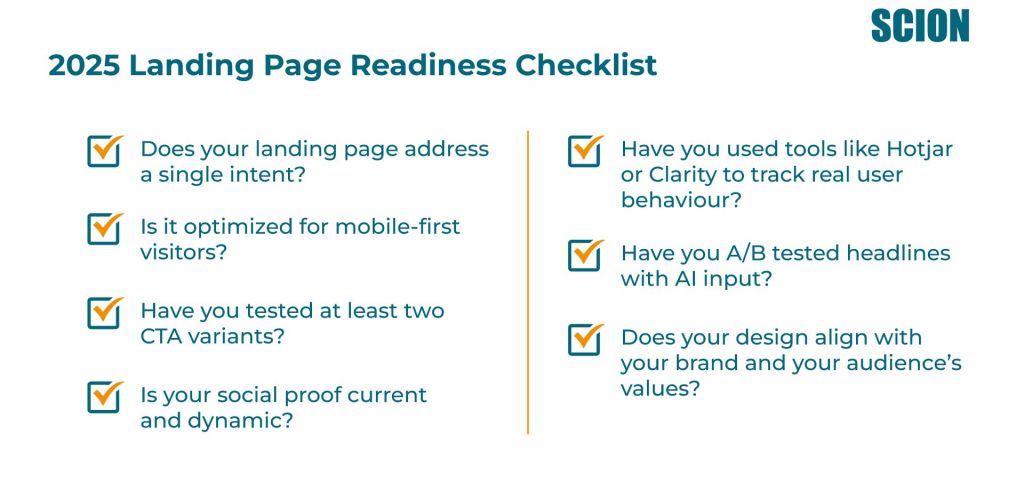
Now’s the time to refresh your pages. Because even small updates today can unlock big conversion wins tomorrow.
